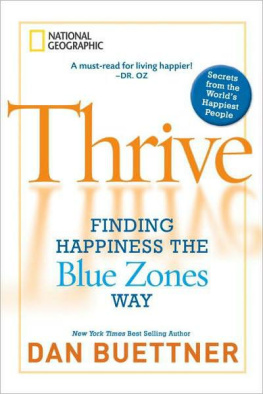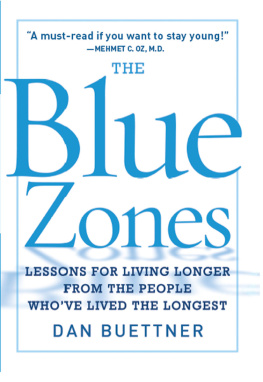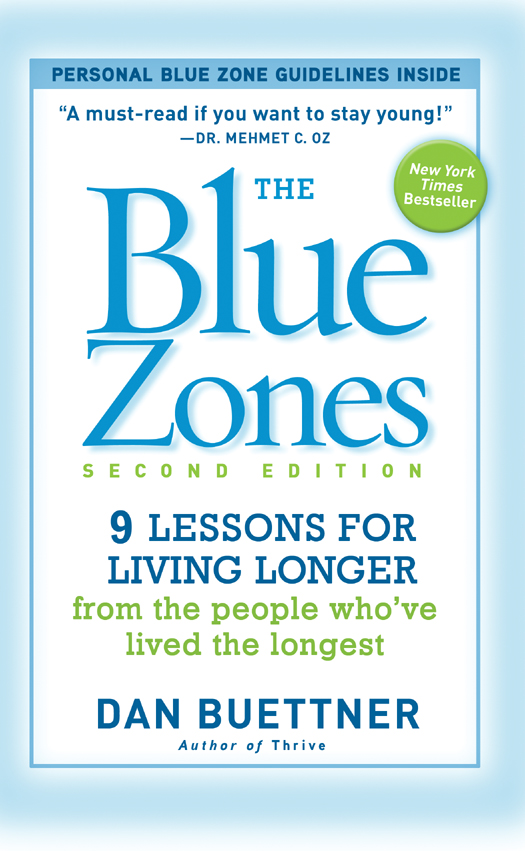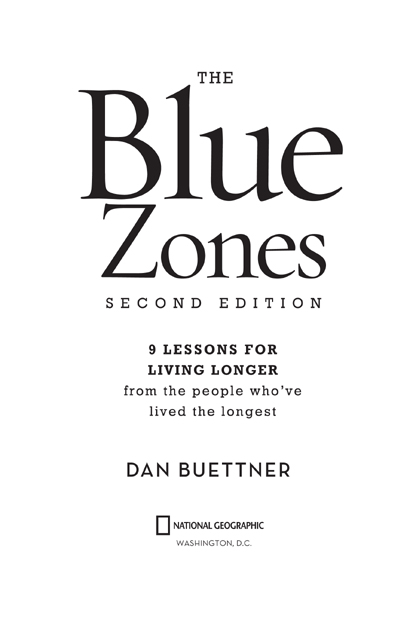Published by the National Geographic Society
Copyright 2008, 2012 Dan Buettner
All rights reserved. Reproduction of the whole or any part of the contents without written permission from the publisher is prohibited.
Illustration Credits: : David McLain/NGS Image Collection.
The Library of Congress has cataloged the first edition as follows:
Buettner, Dan.
The blue zones : lessons for living longer from the people whove lived the longest / by Dan Buettner.
p. cm.
Includes bibliographical references.
eISBN: 978-1-4262-0949-9
1. Longevity. 2. Medical geography. I. Title.
RA776.75.B84 2008
613.2dc22
2007044375

The National Geographic Society is one of the worlds largest nonprofit scientific and educational organizations. Founded in 1888 to increase and diffuse geographic knowledge, the Societys mission is to inspire people to care about the planet. It reaches more than 400 million people worldwide each month through its official journal, National Geographic, and other magazines; National Geographic Channel; television documentaries; music; radio; films; books; DVDs; maps; exhibitions; live events; school publishing programs; interactive media; and merchandise. National Geographic has funded more than 10,000 scientific research, conservation and exploration projects and supports an education program promoting geographic literacy. For more information, visit www.nationalgeographic.com.
For more information, please call 1-800-NGS LINE (647-5463) or write to the following address:
National Geographic Society
1145 17th Street N.W.
Washington, D.C. 20036-4688 U.S.A.
Visit us online at www.nationalgeographic.com
For rights or permissions inquiries, please contact National Geographic Books Subsidiary Rights:
v3.1
For Roger and Dolly
A MESSAGE TO THE READER
This publication contains the opinions and ideas of its author. It is intended to provide helpful and informative material on the subjects addressed in the publication. It is sold with the understanding that the authors and publisher are not engaged in rendering medical, health, or any other kind of personal professional services in the book. The reader should consult his or her medical, health, or other competent professional before adopting any of the suggestions in this book or drawing inferences from it.
The authors and publisher specifically disclaim all responsibility for any liability, loss, or risk, personal or otherwise, which is incurred as a consequence, directly or indirectly, of the use and application of any of the contents in this book.
Contents
Preface
Get Ready to Change Your Life
Chapter One
The Truth About Living Longer
Chapter Two
The Sardinian Blue Zone
Chapter Three
The Blue Zone in Okinawa
Chapter Four
An American Blue Zone
Chapter Five
Discovering Costa Ricas Blue Zone
Chapter Six
The Greek Blue Zone
Chapter Seven
Your Personal Blue Zone
Acknowledgments
W ITHOUT THE UNIVERSITY OF MINNESOTAS Dr. Robert Kane, who endorsed and helped shape the Blue Zones premise, this book would have never materialized. He and his colleagues from the National Institute on Aging, Dr. Jack Guralnik, Dr. Luigi Ferrucci and Dr. Paul Costas; Dr. Thomas Perls from the New England Centenarian Study; Dr. Greg Plotnikoff, Medical Director of Allinas Institute for Health and Healing; University of Louvains Dr. Michel Poulain and University of Illinois, Chicagos Dr. S. Jay Olshansky would spend countless hours sharing expertise, identifying locations, developing methodologies, and ultimately keeping me on the path of science and off the short cuts of conjecture and hyperbole. I cannot thank them enough.
Of the many experts around the world who contributed to this project, I am especially indebted to Dr. Craig Willcox, Dr. Bradley Willcox, Dr. Mokoto Suzuki of the Okinawa Centenarian study; Dr. Tatsama; Dr. Luca Deiana of Sardinias AKEA Study and his incandescently brilliant protg Dr. Gianni Pes; Dr. Paolo Francalacci; Drs. Gary Fraser and Terry Butler of the Adventist Health Study; Dr. Luis Rosero-Bixby of the Central American Population Center; and Dr. Leonardo Mata. They not only lent their expertise but also extended their hospitality and generosity of spirit. Dr. Len Hayflick, Dr. Jack Weatherford, and Dr. Richard Suzman graciously consented to many long interviews. The faculty at the University of Minnesotas School of Public Health, including Dr. Robert Jeffreys, Dr. Tatyana Shamliyan, Dr. Robert W. Jeffery, Dr. John Finnegan, Dr. Cheryl Perry, and especially Dr. Leslie Lytle have been and still are my academic partners.
Many of the experiences on which this book is based reflect a shared effort by the members of Quest Team who have traveled with me to the Blue Zones. Photographer and longtime expedition partner David McLain deserves much of the credit in developing the Blue Zones idea. Nick Buettner, Damian Petrou, Gianluca Colla, Sabriya Rice, Rachel Binns, Sayoko Ogata, Dr. Elizabeth Lopez, Eliza Thomas, Tom Adair, Michael Mintz, Meshach Weber, Thad Dahlberg, Eric Luoma, Joseph Van Harken, and Suzanne Pfeifer all shared their ample talents and endured many long days and nights to bring Blue Zones to life.
This story would have never been told without Peter Miller, my editor at National Geographic. He backed the idea for the original magazine story and guided me through my first drafts of the book. Michelle Harris further improved the book through her thorough fact checking, and Dr. Robert M. Russells review of our chapters helped keep us on track. Also at National Geographic, I thank Lisa Thomas and Amy Briggs for orchestrating this book; Rebecca Martin for shepherding us through the Expeditions Council grant process; Valerie May and Miki Meek for bringing Blue Zones to life online; and picture editor Susan Welchman for her fiercely relentless friendship and guidance. Assistants Jorge Vindas (Costa Rica), Marisa Montebella (Sardinia), and Kadowaki Kunio (Okinawa) were the unseen engines behind our successful stories.
No project of this magnitude happens without sponsors and financial partners. I wish to especially thank Marty Davis, the Davis family, and DAVISCO for their commitment to health and vast generosity; Jane Shure from the National Institute on Aging who was instrumental in obtaining our initial funding from the National Institutes of Health; Becky Malkerson, John Helgerson, Laura Juergens, and Maria Lindsley who championed Blue Zones at Allianz Life; Valerie May and Nancy Graham for navigating the waters at AARP; Nishino Hiroshi who found most of the funding in Japan; the Target Foundation, the Best Buy Foundation, Lawson Software, and the National Geographic Expeditions Council.
At Blue Zones Minneapolis headquarters, Scott Meyer has been our mentor and marketing guru from the very beginning. The office team: Matt Osterman, Sarah Kast, Phil Noyed, Amy Tomczyk, Nancy Fuller McRae, and Jennifer Havrish have endlessly helped with research, proofreading, and have patiently endured my nonlinear methods; and the extended team including PR maven Laura Reynolds; Remar Sutton, Dr. Mary Abbott Waite, and the late George Plimpton, who provided crucial editorial assistance; Britt Robson for his help on the Okinawa and Loma Linda Chapters; our advisors including Tom Rothstein, Frank Roffers, Elwin Loomis, Jon Norberg, Ed McCall, Tom Gegax, Kevin Moore, Molly Goodyear, Chris Mahai, John Foley, and John Gabos who lent generous business advice; Thad Dahlberg, Dan Grigsby, and Bruno Bornstein, who built the Blue Zones website; and Keiko Takahashi, who created the Blue Zones identity.












